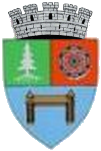Câmpeni
|
Câmpeni Topesdorf Topánfalva |
||||
|
||||
| Basic data | ||||
|---|---|---|---|---|
| State : |
|
|||
| Historical region : | Transylvania | |||
| Circle : | Alba | |||
| Coordinates : | 46 ° 22 ' N , 23 ° 3' E | |||
| Time zone : | EET ( UTC +2) | |||
| Height : | 553 m | |||
| Area : | 86.6 km² | |||
| Residents : | 7,221 (October 20, 2011) | |||
| Population density : | 83 inhabitants per km² | |||
| Postal code : | 515500 | |||
| Telephone code : | (+40) 02 58 | |||
| License plate : | FROM | |||
| Structure and administration (as of 2016) | ||||
| Community type : | city | |||
| Structure : | 20 Gemarkungen / Katastralgemeinden: Bonceşti , Borlesti , BOTESTI , Dânduţ , Dric , Certege , Coastâ Vâscului , Dealul Capsei , FATA Abrudului , Floreşti , Furduieşti , Mihoieşti , Motorăşti , Peste Valea Bistrii , Poduri , Sorliţa , Tomuşeşti , Valea Bistrii , Valea Caselor , Vârși | |||
| Mayor : | Ioan-Călin Andreș ( PSD ) | |||
| Postal address : | St. Avram Iancu, no. 5 loc. Câmpeni, jud. Alba, RO-515500 |
|||
| Website : | ||||
Câmpeni ( German Topesdorf or Topersdorf , Hungarian Topánfalva ) is a Romanian city in the Alba district in Transylvania .
Geographical location
Câmpeni is located in the center of the Apuseni Mountains , between the Găina mountain ranges in the west, Muntele Mare in the north and the Transylvanian Ore Mountains in the southeast. In the city, the Abrud River flows into the Arieș . The district capital Alba Iulia is located about 80 kilometers south-east. Câmpeni is the center of the Motzenland .
history
The first documentary mention comes from the year 1565. At that time the place belonged to the Principality of Transylvania . About 25 years later, the Transylvanian Prince Sigismund Báthory granted the Romanian noble family Filimon permission to operate a mill on Arieș. As a result, Câmpeni developed into a center of the Romanian ethnic group in Transylvania; In contrast to most other regions of the principality, there was a Romanian upper class here. At the end of the 17th century, Câmpeni came to Austria-Hungary . In the 18th century it had 5,400 inhabitants and is said to have been larger than Alba Iulia or Târgu Mureș . Mining played an essential role, especially gold mining. In addition, many residents lived from agriculture and livestock farming. Social tensions and national oppression sparked multiple riots. In 1782 there was a local peasant rebellion. In 1784/85 a revolt of serf peasants broke out under the leaders Horea, Cloşca and Crişan, which was bloodily suppressed. In 1848/49 the region around Câmpeni was the scene of fighting between Romanian revolutionaries under Avram Iancu and Habsburg troops.
After the First World War , Câmpeni became part of Romania. In economic terms, wood extraction and processing increasingly dominated. Some smaller industrial companies settled there. In 1961, Câmpeni was declared a city.
population
In 1850, 2894 inhabitants lived in the area of today's city. 2,800 were Romanians , 33 Hungarians , 25 Germans and 23 Roma . In 1992, the largest population was registered with 8878. At the 2002 census there were 8,080 people in Câmpeni, including 7,810 Romanians, 248 Roma and 14 Hungarians. 5238 lived in Câmpeni, the remaining 2572 in the 20 incorporated towns.
traffic
Câmpeni is located on the narrow-gauge railway from Turda to Abrud, which opened in 1912 . This has been closed to regular traffic since the late 1990s; On the section between Abrud and Câmpeni, some trains run sporadically for tourist purposes. There are bus connections to Turda. The national road ( Drum național ) DN 75 leads through Câmpeni from Turda to Ștei .
Attractions
- Avram Iancus equestrian monument, erected in 1940 in the city center, is a listed building.
- The Avram Iancu Museum
Personalities
- Gustav Conrad (1875–1923), pedagogue and orphanage director in Sibiu
- Valerian Trifa (1914–1987), Romanian Orthodox priest and fascist politician
Web links
Individual evidence
- ↑ 2011 census in Romania ( MS Excel ; 1.3 MB)
- ↑ Mayoral elections 2016 in Romania ( MS Excel ; 256 kB)
- ^ Dictionary of localities from Transylvania
- ↑ Heinz Heltmann, Gustav Servatius (Ed.): Travel Guide Siebenbürgen. Kraft-Verlag, Würzburg 1993, ISBN 3-8083-2019-2 .
- ↑ România Pitoreascâ, accessed on February 26, 2009 ( Memento of the original from March 6, 2016 in the Internet Archive ) Info: The archive link was inserted automatically and has not yet been checked. Please check the original and archive link according to the instructions and then remove this notice.
- ↑ William Ramming of Ried churches : The summer campaign of the Revolutionary War in Transylvania in 1849. Publisher FA Credner, Prague 1864th
- ↑ 2002 census, accessed on February 26, 2009 (PDF file; 1.14 MB)
- ↑ Pictures of the narrow-gauge railway between Turda and Abrud , on YouTube
- ↑ List of historical monuments of the Romanian Ministry of Culture, updated 2010, accessed on July 30, 2013 ( Memento of the original from June 10, 2012 in the Internet Archive ) Info: The archive link was automatically inserted and not yet checked. Please check the original and archive link according to the instructions and then remove this notice. (PDF; 7.10 MB)
- ↑ "Câmpeni and the Muzeul Avram Iancu", on www.karpatenwilli.com
- ↑ The Avram Iancu Museum ( Memento of the original from October 2, 2012 in the Internet Archive ) Info: The archive link was inserted automatically and has not yet been checked. Please check the original and archive link according to the instructions and then remove this notice. (Romanian)
- ↑ Valerian D. Trifa at alternativaonline.ca







